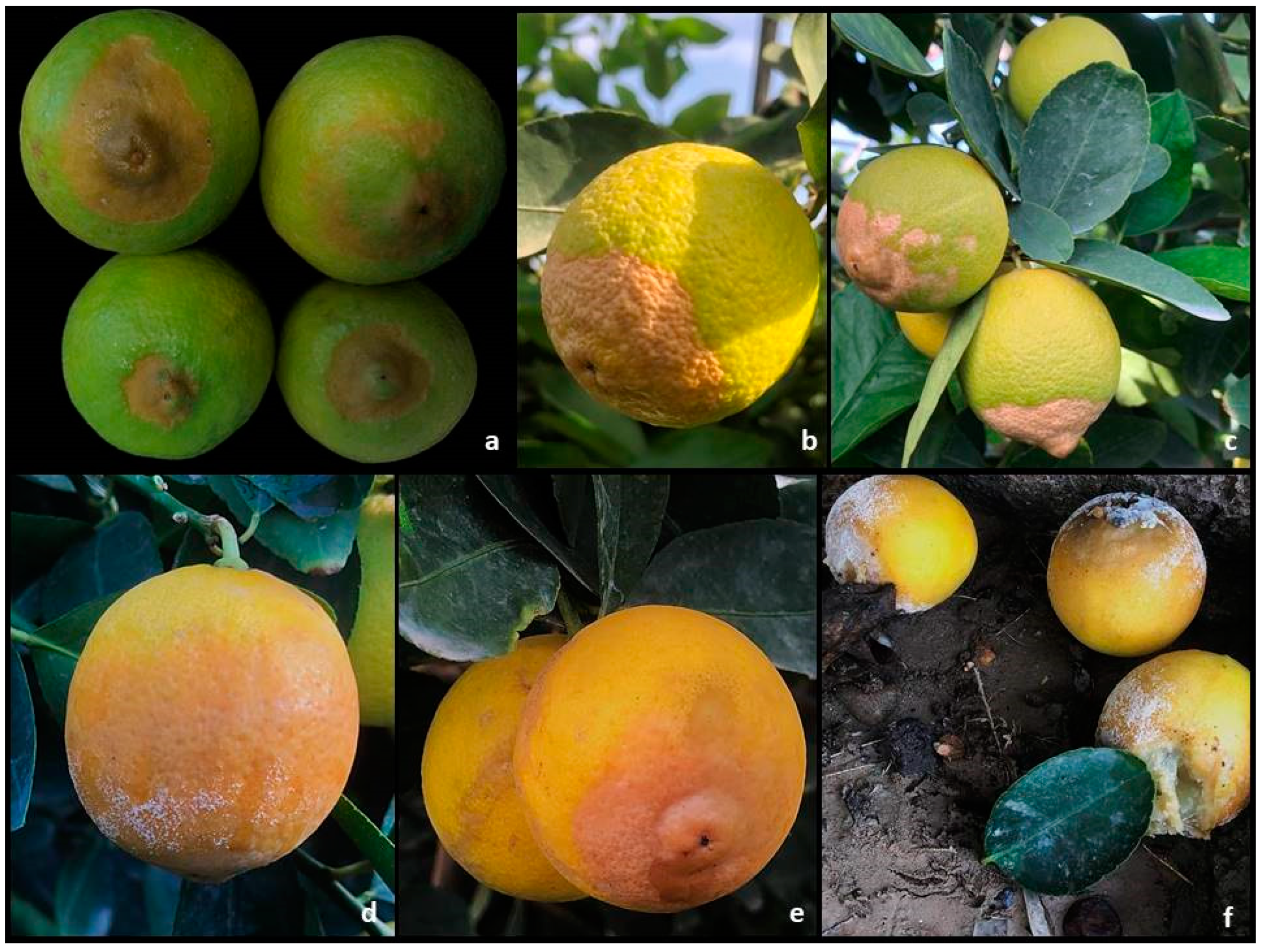Unusual Stylar-End Breakdown and Sour Rot on Key Lime (Citrus aurantiifolia) in Pre-Harvest Condition in Italy
Abstract
1. Introduction
2. Results
3. Discussion
4. Materials and Methods
4.1. Isolation
4.2. Morphological and Molecular Characterization
4.3. Pathogenicity Test
5. Conclusions
Author Contributions
Funding
Institutional Review Board Statement
Data Availability Statement
Conflicts of Interest
References
- Mabberley, D. Citrus (Rutaceae): A review of recent advances in etymology, systematics and medical applications. Blumea Biodivers. Evol. Biogeogr. Plants 2004, 49, 481–498. [Google Scholar] [CrossRef]
- USDA. Citrus: World Markets and Trade; United States Department of Agriculture, Foreign Agricultural Service, Office of Global Analysis: Washington, DC, USA, 2021; p. 13.
- Donkersley, P.; Silva, F.W.; Carvalho, C.M.; Al-Sadi, A.M.; Elliot, S.L. Biological, environmental and socioeconomic threats to citrus lime production. J. Plant Dis. Prot. 2018, 125, 339–356. [Google Scholar] [CrossRef]
- Al-Sadi, A.M.; Queiroz, R.B.; Donkersley, P.; Nasehi, A.; Elliot, S.L. Plant Protection: Lime Diseases and Insect Pests. In The Lime: Botany, Production and Uses; Khan, M.M., Al-Yahyai, R., Al-Said, F., Eds.; CABI: Wallingford, UK, 2017; pp. 149–166. [Google Scholar] [CrossRef]
- Rivera-Cabrera, F.; Ponce-Valadez, M.; Sanchez, F.; Villegas-Monter, A.; Perez-Flores, L. Acid limes. A Review. Fresh Prod. 2010, 4, 116–122. [Google Scholar]
- Morsy, A.A.; Abd El-Kader, M.M. Occurrence of lime sour rot in Egypt. In Proceedings of the 7th Congress of Egyption Phytopathology Society, Giza, Egypt, April 1994; pp. 251–256. [Google Scholar]
- Hernández-Montiel, L.G.; Holguín-Peña, R.J.; Latisnere-Barragan, H. First report of sour rot caused by Geotrichum citri-aurantii on Key Lime (Citrus aurantifolia) in Colima State, Mexico. Plant Dis. 2010, 94, 488. [Google Scholar] [CrossRef] [PubMed]
- Ferguson, L.; Grafton-Cardwell, E.E. Citrus Production Manual; UCANR Publications: Oakland, CA, USA, 2014; Volume 433. [Google Scholar]
- Groenewald, M.; Coutinho, T.; Smith, M.T.; van der Walt, J.P. Species reassignment of Geotrichum bryndzae, Geotrichum phurueaensis, Geotrichum silvicola and Geotrichum vulgare based on phylogenetic analyses and mating compatibility. Int. J. Syst. Evol. Microbiol. 2012, 62, 3072–3080. [Google Scholar] [CrossRef] [PubMed]
- Alper, I.; Frenette, M.; Labrie, S. Ribosomal DNA polymorphisms in the yeast Geotrichum candidum. Fungal Biol. 2011, 115, 1259–1269. [Google Scholar] [CrossRef] [PubMed]
- De Hoog, G.S.; Smith, M.T. Ribosomal gene phylogeny and species delimitation in Geotrichum and its teleomorphs. Stud. Mycol. 2004, 50, 489–515. [Google Scholar]
- Smith, C.O. Sour rot of lemon in California. Phytopathology 1917, 7, 37–41. [Google Scholar]
- Timmer, L.W.; Garnsey, S.M.; Graham, J.H. (Eds.) Compendium of Citrus Diseases, 2nd ed.; The American Phytopathological Society (APS): St. Paul, MI, USA, 1999; Volume 43. [Google Scholar]
- Davenport, T.L.; Campbell, C.W.; Orth, P.G. Stylar-end breakdown in ’Tahiti’ lime: Some causes and cures. In Proceedings of the Florida State Horticultural Society, Miami Beach, FL, USA, 2–4 November 1976; Volume 89, pp. 245–247. [Google Scholar]
- Baudoin, A.B.A.M.; Eckert, J.W. Factors influencing the susceptibility of lemons to infection by Geotrichum candidum. Phytopathology 1982, 72, 1592–1597. [Google Scholar] [CrossRef]
- Rose, D.H.; Brooks, C.; Bratley, C.O.; Winston, J.R. Market Diseases of Fruits and Vegetables: Citrus and other Subtropical Fruits; Miscellaneous Publication-Department of Agriculture: Washington, DC, USA, 1943; Volume 498, p. 16.
- Yaghmour, M.A.; Bostock, R.M.; Morgan, D.P.; Michailides, T.J. Biology and sources of inoculum of Geotrichum candidum causing sour rot of peach and nectarine fruit in California. Plant Dis. 2012, 96, 204–210. [Google Scholar] [CrossRef] [PubMed]
- Butler, E.E.; Eckert, J.W. A sensitive method for isolation of Geotrichum candidum from soil. Mycologia 1962, 54, 106–109. [Google Scholar] [CrossRef]
- Hershenhorn, J.; Dori, S.; Barash, I. Association of Geotrichum citri-aurantii with citrus groves in Israel. Phytoparasitica 1992, 20, 31–36. [Google Scholar] [CrossRef]
- Gardes, M.; Bruns, T.D. ITS primers with enhanced specificity for basidiomycetes: Application to the identification of mycorrhizae andrusts. Mol. Ecol. 1993, 2, 113–118. [Google Scholar] [CrossRef] [PubMed]
- White, T.J.; Bruns, T.; Lee, S.; Taylor, J.W. Amplification and direct sequencing of fungal ribosomal RNA genes for phylogenetics. In PCR Protocols: A Guide to Methods and Applications; Innis, M.A., Gelfand, D.H., Sninsky, J.J., White, T.J., Eds.; Academic Press: San Diego, CA, USA, 1990; pp. 315–322. [Google Scholar]
- Kumar, S.; Stecher, G.; Li, M.; Knyaz, C.; Tamura, K. MEGA X: Molecular evolutionary genetics analysis across computing platforms. Mol. Biol. Evol. 2018, 35, 1547–1549. [Google Scholar] [CrossRef] [PubMed]
- Altschul, S.F.; Madden, T.L.; Schaffer, A.A.; Zhang, Z.; Miller, W.; Lipman, D.J. Gapped BLAST and PSI-BLAST: A new generation of protein databases search programs. Nucleic Acids Res. 1997, 25, 3389–3402. [Google Scholar] [CrossRef] [PubMed]


| Treatment Conditions | D.I. 48 h | D.I. 7 Days |
|---|---|---|
| Over-ripe lime 25 °C | 22% | 77% |
| Ripe (green) lime 25 °C | 0% | 0% |
| Over-ripe lime 4 °C | 0% | 0% |
| Ripe lemon 25 °C | 0% | 55% |
| Ripe lemon 4 °C | 0% | 0% |
| Control | 0% | 0% |
Publisher’s Note: MDPI stays neutral with regard to jurisdictional claims in published maps and institutional affiliations. |
© 2021 by the authors. Licensee MDPI, Basel, Switzerland. This article is an open access article distributed under the terms and conditions of the Creative Commons Attribution (CC BY) license (https://creativecommons.org/licenses/by/4.0/).
Share and Cite
Gusella, G.; Fiorenza, A.; Aiello, D.; Polizzi, G. Unusual Stylar-End Breakdown and Sour Rot on Key Lime (Citrus aurantiifolia) in Pre-Harvest Condition in Italy. Plants 2021, 10, 989. https://doi.org/10.3390/plants10050989
Gusella G, Fiorenza A, Aiello D, Polizzi G. Unusual Stylar-End Breakdown and Sour Rot on Key Lime (Citrus aurantiifolia) in Pre-Harvest Condition in Italy. Plants. 2021; 10(5):989. https://doi.org/10.3390/plants10050989
Chicago/Turabian StyleGusella, Giorgio, Alberto Fiorenza, Dalia Aiello, and Giancarlo Polizzi. 2021. "Unusual Stylar-End Breakdown and Sour Rot on Key Lime (Citrus aurantiifolia) in Pre-Harvest Condition in Italy" Plants 10, no. 5: 989. https://doi.org/10.3390/plants10050989
APA StyleGusella, G., Fiorenza, A., Aiello, D., & Polizzi, G. (2021). Unusual Stylar-End Breakdown and Sour Rot on Key Lime (Citrus aurantiifolia) in Pre-Harvest Condition in Italy. Plants, 10(5), 989. https://doi.org/10.3390/plants10050989






